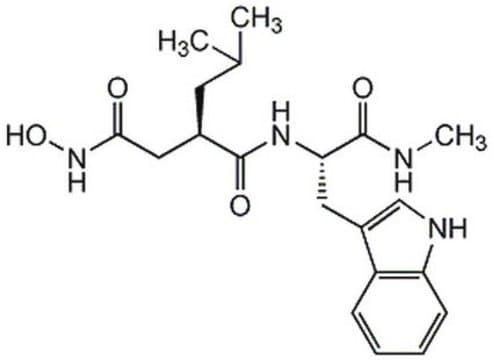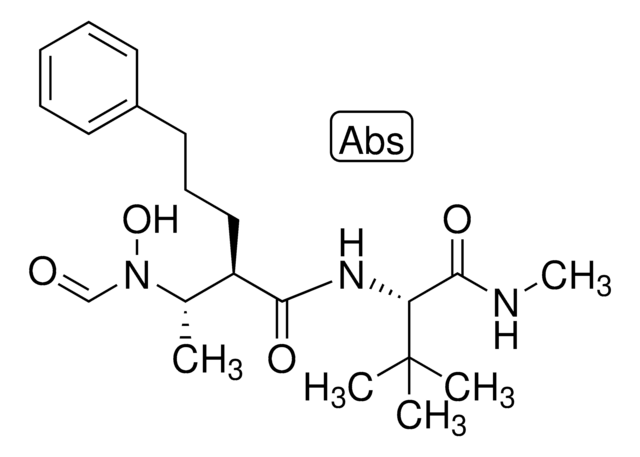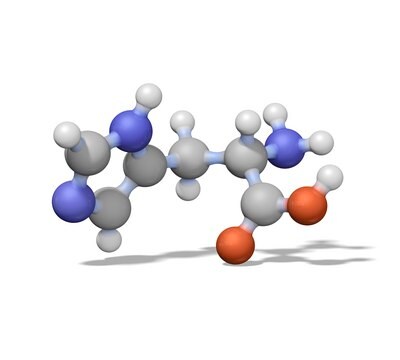565788
β-Secretase Inhibitor IV
≥98% (HPLC), solid, β-secretase inhibitor, Calbiochem®
Synonim(y):
Inhibitor BACE C3
Wybierz wielkość
1380,00 zł
Przewidywany termin wysyłki22 kwietnia 2025Szczegóły
Wybierz wielkość
About This Item
1380,00 zł
Przewidywany termin wysyłki22 kwietnia 2025Szczegóły
Polecane produkty
Nazwa produktu
β-Secretase Inhibitor IV, β-Secretase Inhibitor IV, CAS 797035-11-1, is a cell-permeable inhibitor that binds to BACE-1 active site and blocks its proteolytic activity (IC₅₀ = 15 nM for human BACE-1).
Poziom jakości
Próba
≥98% (HPLC)
Formularz
solid
producent / nazwa handlowa
Calbiochem®
warunki przechowywania
OK to freeze
protect from light
kolor
white
rozpuszczalność
DMSO: 100 mg/mL
Warunki transportu
ambient
temp. przechowywania
2-8°C
ciąg SMILES
[S](=O)(=O)(N(C)c1cc(cc(c1)C(=O)N[C@H](C)c4ccccc4)C(=O)N[C@H]([C@H](O)CNC3CC3)Cc2ccccc2)C
InChI
1S/C31H38N4O5S/c1-21(23-12-8-5-9-13-23)33-30(37)24-17-25(19-27(18-24)35(2)41(3,39)40)31(38)34-28(16-22-10-6-4-7-11-22)29(36)20-32-26-14-15-26/h4-13,17-19,21,26,28-29,32,36H,14-16,20H2,1-3H3,(H,33,37)(H,34,38)/t21-,28+,29-/m1/s1
Klucz InChI
VPNIQGRFZCTBEZ-SPTGULJVSA-N
Opis ogólny
Działania biochem./fizjol.
BACE-1 human
Opakowanie
Ostrzeżenie
Rekonstytucja
Inne uwagi
Stachel, S.J., et al. 2004. J. Med. Chem.47, 6447.
Informacje prawne
Kod klasy składowania
11 - Combustible Solids
Klasa zagrożenia wodnego (WGK)
WGK 1
Temperatura zapłonu (°F)
Not applicable
Temperatura zapłonu (°C)
Not applicable
Certyfikaty analizy (CoA)
Poszukaj Certyfikaty analizy (CoA), wpisując numer partii/serii produktów. Numery serii i partii można znaleźć na etykiecie produktu po słowach „seria” lub „partia”.
Masz już ten produkt?
Dokumenty związane z niedawno zakupionymi produktami zostały zamieszczone w Bibliotece dokumentów.
Active Filters
Nasz zespół naukowców ma doświadczenie we wszystkich obszarach badań, w tym w naukach przyrodniczych, materiałoznawstwie, syntezie chemicznej, chromatografii, analityce i wielu innych dziedzinach.
Skontaktuj się z zespołem ds. pomocy technicznej








